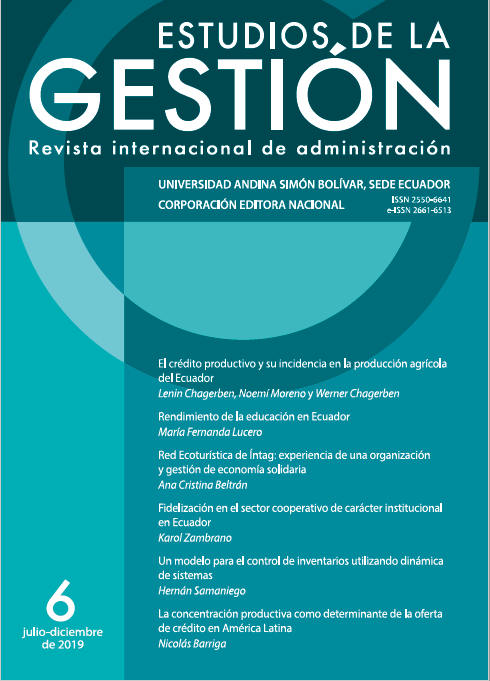Rendimiento de la educación en Ecuador
DOI:
https://doi.org/10.32719/25506641.2019.6.2Palabras clave:
Rendimiento educativo, mercado laboral, ingresosResumen
La relación entre educación e ingresos, establecida por la teoría del capital humano, propone tratar la educación como uno de los principales determinantes del nivel de ingresos de los individuos. No obstante, si bien la teoría confirma que la educación ofrece una ventaja para obtener mayores ingresos, a partir del siglo XXI se discuten hipótesis que señalan rendimientos decrecientes en la educación. Bajo este contexto, el objetivo del presente estudio es analizar la relación empírica existente entre el ingreso de personas asalariadas y los niveles de educación, así como la evolución del retorno educativo para el período 2007-2017 en Ecuador. Para su demostración, se emplearon modelos de corte transversal para cada año, utilizando datos de la encuesta nacional de empleo, desempleo y subempleo (ENEMDU) con base en la ecuación de Mincer, estimados mediante la aplicación de diseño muestral. En este escenario, los resultados confirman la ventaja que ofrece la educación en la obtención de ingresos, sin embargo, se concluye que esta ventaja presenta un comportamiento decreciente.
Descargas
Referencias
Atonji, Joseph, y Rebecca Blank. 1999. “Race and Gender in the Labor Market”. Handbook of Labor Economics, No. 3: 3143-3259. ‹https://econpapers.repec.org/bookchap/eeelabchp/3-48.htm›.
Azevedo, Pedro, Eugenia Dávalos, Carolina Díaz, Bernando Atuesta y Raúl Castañeda. 2013. “Fifteen Years of Inequality in Latin America: ¿How Have Labor Markets Helped?”. The World Bank. Consulta: abril de 2019. ‹http://bit.ly/32KT7rG›.
Barceinas, Fernando. 1999. “Función de ingresos y rendimiento de la educación en México”. Estudios Económicos 14 (1): 87-127. ‹https://www.jstor.org/stable/40311420›.
---, Joseph Alonso, José Raymond y José Roig. 2001. “Hipótesis de señalización frente a capital humano”. Revista de Economía Aplicada 9 (26): 125-147. ‹https://dialnet.unirioja.es/servlet/articulo?codigo=176865›.
Barth, Michael. 1978. “Generating Inequality: A Review Article”. The Journal of Human Resource 12 (1): 92-102. Doi: 10.2307/145600.
Becker, Gary. 1962. “Investment in Human Capital: A Theoretical Analysis”. Journal of Political Economy 70 (5): 9-49. ‹https://www.jstor.org/stable/1829103›.
---. 1994. Human Capital: A Theoretical and Empirical Analysis with Special Reference to Education. Chicago: University of Chicago Press.
Blaug, Mark. 1967. “The Private and the Social Returns on Investment in Education: Some Results for Great Britain”. The Journal of Human Resource 2 (3): 330-346. Doi: 10.2307/144838.
Cardona, Marleny, Isabel Montes, José Vázquez, María Villegas y Tatiana Brito. 2007. “Capital humano: una mirada desde la educación y experiencia laboral”. Cuadernos de Investigación 56 (1): 1-31. ‹https://bit.ly/2qbyYcD›.
Carnoy, Martin. 1967. “The Rate of Return to Schooling in Latin America”. Comparative Education Review 16 (1): 68-86. ‹http://www.jstor.org/stable/1186343›.
Carrillo, Paúl. 2004. “Las diferencias salariales entre el sector público y privado en el Ecuador”. Cuestiones Económicas 20 (2: 3): 166-173. ‹http://bit.ly/2pqZ1PN›.
Comisión Económica para América Latina y el Caribe (CEPAL). 2015. “Perspectivas económicas de América Latina 2015: educación, competencias e innovación para el desarrollo”. Consulta: mayo de 2019. ‹https://bit.ly/31prbI5›.
EC Instituto Nacional de Estadística y Censos (INEC). 2014. “Metodología del diseño muestral de la Encuesta Nacional de Empleo y Desempleo ENEMDU”. Consulta: mayo de 2019. ‹https://bit.ly/2A7gRtY›.
---. 2018. “Encuesta nacional de empleo desempleo y subempleo”. Consulta: mayo de 2019. ‹https://bit.ly/2IroH3P›.
EC Ministerio de Educación. 2017. “Estructuras ocupacionales: salarios mínimos sectoriales y tarifas”. Consulta: mayo de 2019. ‹https://bit.ly/2ITt2OX›.
Gestión y Excelencia Educativa. 2013. “Inversión para mejorar la infraestructura educativa”. Consulta: mayo de 2019. ‹https://bit.ly/2Mlk8fv›.
Griliches, Zvi. 1977. “Estimating the Returns to Schooling: Some Econometric Problems”. Econometrica 45 (1): 1-22. Doi:10.2307/1913285.
Harbinson, Frederick, y Charles Myers. 1964. “Education, Manpower and Economic Growth”. Science 145 (3635): 1-917. Doi: 10.1126/science.145.3635.917.
Marshall, Alfredo. 1890. Principios de economía. Introducción al estudio de esta ciencia. Barcelona: Biblioteca de Cultura Económica XI.
Messina, Julián, y Joanna Silva. 2017. “Desigualdad de ingresos en América Latina”. Grupo Banco Mundial. Consulta: abril de 2019. ‹https://bit.ly/2MjQ6Zq›.
Mill, John S. 1885/2009. Principles of Political Economy. Nueva York: D. Appleton And Company. ‹https://www.gutenberg.org/files/30107/30107-pdf.pdf›.
Mincer, Jacob. 1958. “Investment in Human Capital and Personal Income Distribution”. Journal of Political Economy 66 (4): 281-302. ‹https://www.jstor.org/stable/1827422›.
---. 1974. Schooling, Experience and Earnings. Nueva York: National Bureau of Economic Research.
Organización de las Naciones Unidas para la Educación, la Ciencia y la Cultura (UNESCO). 2013. “Situación educativa de América Latina y el Caribe. Hacia la educación de calidad para todos al 2015”. Consulta: mayo de 2019. ‹https://bit.ly/2IRxwpx›.
---. 2018. “Gasto público en la educación de América Latina”. Consulta: mayo de 2019. ‹https://bit.ly/2mE9vtR›.
---. 2018. Rendir cuentas en el ámbito de la educación: cumplir nuestros compromisos, resumen del informe de seguimiento de la educación en el mundo. Consulta: mayo de 2019. ‹http://bit.ly/35Io29N›.
Oroval, Esteve, y Oriol Escardibul. 1998. Economía de la educación. Madrid: Ediciones Encuentro. Pampillón, Rafael. 2001. “¿Qué son las externalidades?”. Diccionario de economía, energía, medio ambiente y cambio climático. Consulta: abril de 2019. ‹http://bit.ly/2PfIol4›.
Parodi, Sandro, Indira Ramírez y Jennelle Thompson. 2017. Tasas de retorno de la inversión en educación en la República Dominicana (2000-2015). Washington D. C.: Banco Interamericano de Desarrollo.
Paz, Peter, y Carlos Urrutia. 2015. “Productividad en el Perú: medición, determinantes e implicancias”. Universidad del Pacífico, Lima. Consulta: mayo de 2019. ‹https://bit.ly/2IWAXLr›.
Perry, Guillermo, Omar Arias, Humberto López, William Maloney y Luis Serven. 2006. “Reducción de la pobreza: círculos virtuosos y círculos viciosos”. Banco Mundial. Consulta: abril de 2019. ‹http://reducción-lapobreza-y-crecimientpo círculosvirtuosos-y-círculos-viciosos/›.
Petty, William. 1899. The Economic Writings. Reino Unido: Cambridge University Press. Psacharopoulos, George, y Harry Patrinos. 2018. “Returns to Investment in Education. A Decennial Review of the Global Literature”. The World Bank. Consulta: mayo de 2019. ‹https://bit.ly/2MjR1Jm›.
Schultz, Theodore W. 1960. “Capital Formation by Education”. Journal of Political Economy 68 (6): 571-83. ‹https://bit.ly/2VNOiuN›.
---. 1961. “Investment in Human Capital”. The American Economic Review 51 (1): 1-17. ‹https://www.jstor.org/stable/1818907›.
Smith, Adam. 1958. Investigación de la naturaleza y causas de las riquezas de las naciones. (Traducido por Gabriel Franco). Buenos Aires: Biblioteca OMEGALFA.
Thurow, Lester. 1975. Generating Inequality: Mechanisms of Distribution in the U. S. Economy. Londres: Basic Books Inc.
Williamson, Stephen. 2012. Macroeconomía. Madrid: Pearson Education.
Yamada, Gustavo. 2007. “Retornos a la educación superior en el mercado laboral. ¿Vale la pena el esfuerzo?”. Economía 31(61): 207-210. ‹https://bit.ly/2VRy8k7›.
---. 2016. “Educación superior y subempleo profesional: ¿una creciente burbuja mundial?”. (PER) Ministerio de Educación. Consulta: mayo de 2019. ‹http://repositorio.minedu.gob.pe/handle/123456789/5097›













